Teaching Core Vocabulary
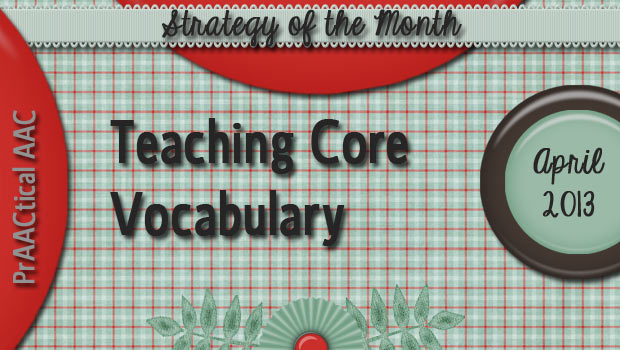
Among the many changes that the AAC field has experienced in the last decade is the notion that core vocabulary is (or should be) an integral part of any AAC system. We grew to understand the limitations of AAC supports that consist primarily of nouns and descriptors, realizing that those kinds of communication displays restricted our clients to requesting and labeling. Our field realized the inadequacy of providing only prestored messages (e.g., limited the client’s ability to communicate anything novel, not flexible enough to meet most communication needs, etc.). In essence, we realized that without core vocabulary, we were imposing a ceiling on language development.
We’re thrilled to see so many communication boards, books, SGDs, and AAC apps reflect this knowledge. Having tools with the appropriate vocabulary is a big step in the right direction. But to really shatter the ceiling of language development, we have to be good at teaching the use of core language. Teaching words like ‘it,’ ‘do,’ and ‘not’ is a lot different than teaching words like ‘cookie’ and ‘bubbles.’ It’s no wonder that SLPs struggle with this: It’s not easy to teach abstract concepts and most core words are a lot more abstract than the nouns, verbs, and descriptors we focused on 10+ years ago.
This month, we’re focusing on ways to teach core language. We’ll start off with some basic principles and the move into applying teaching strategies to lists of core words.
In November, we introduced the framework we use for semantic intervention in AAC that included:
- Introducing the new word(s) using focused AIDED language stimulation;
- Teaching the new word(s) with explicit instruction activities;
- Elaborating on the new word meanings with engaging practice activities;
- Providing repeated exposure to the new word(s) on an ongoing basis; and,
- Checking for understanding and reteaching, as necessary.
That same approach works here, but there are some special considerations in implementation. Activities for explicit instruction of words like ‘have,’ ‘some’ and ‘you’ are a bit different than activities for teaching words like ‘music’ and ‘Play Doh.’
Here are some thoughts to get us started.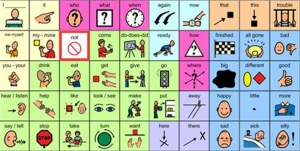
-
Provide access to core vocabulary: Before we can start teaching core vocabulary, we have to give our clients with AAC needs communication tools that have a good base of core vocabulary. That can be done in a no tech way, using communication boards and books. Low tech AAC devices can also be set up for core language. And, of course, some high tech SGDs and AAC apps do that as well.
-
Don’t underestimate the amount of vocabulary needed: It’s tempting to size up beginning communicators who are expressing very little and draw the conclusion that they only need a few dozen words on their AAC devices/tools. If we take that approach, though, we’re limiting their exposure to a wider vocabulary set. Finding the balance between too few and too many takes some clinical judgment-there are no hard and fast rules.
— We approach this pretty much the way we do with speaking children. We model language slightly above their current abilities, right? So with our AAC learners, we provide AAC tools that allow us to do the same thing. If he knows or uses about a dozen words, then I might start with AAC tools that have about 18-24 words. That gives me room to use it to talk to him and provide receptive exposure to words that he doesn’t yet know. Some of them are the next words that we’re planning to teach. Think of it as a ladder. If you don’t provide access to the next rung, he won’t be able to climb. If I only provide access to the words he knows now, how will he ever learn new words?
ladder. If you don’t provide access to the next rung, he won’t be able to climb. If I only provide access to the words he knows now, how will he ever learn new words?
-
Keep the process moving: As the learner starts to catch on to the words you are teaching, add more so you can begin to expose them to new vocabulary. It’s a fluid process.
-
Provide frequent opportunities for core word practice: By definition, core words are common and appropriate for almost every situation. One of the best ways to get learners competent with core vocabulary is to have them say those words frequently. If Jenna’s target words are ‘it,’ ‘do,’ and ‘not,’ then she should be saying them all day long. These words, individually and in short sentences, can be fit into almost any daily routine or activity (e.g. Do it. I do. Do not. You do not). Once they get used to the idea that you will build these opportunities into their routine, pause expectantly, and help them say the words, it will become a normal part of their everyday
-
Expect to provide a lot of support: In the beginning stages of word learning, it’s normal for AAC learners to need help. At this stage, it’s better to give them practice saying the word correctly with some help, than having them fumble around on their own and not say it at all.
-
It’s not about mastery: Try not to get trapped into thinking that AAC learners have to prove that they know their current words before we give them access to more. Instead, look for signs that they are starting to ‘get it.’ We do more harm by restricting access to vocabulary than we do by giving them too many words. Unless you have strong data to show that a particular communicator learns fastest when they achieve mastery before moving on, give them the benefit of the doubt. It’s almost 30 years since Anne Donellan planted this seed. In her 1984 article, she suggested that when we don’t have enough information to be sure, we should operate on the assumption that, if wrong, leads to the least dangerous effect on the outcome.
Teaching core language, the basic set of words we all use to get through our daily lives, can take more thought and planning but the payoffs are huge. Do you have tips for teaching this type of vocabulary? We’d love to hear them!
Donnellan, A. (1984). The criterion of the least dangerous assumption. Behavior Disorders, 9, 2, 141-150.
Filed under: Strategy of the Month
Tagged With: core language, core vocabulary, instructional sequence, vocabulary instruction
This post was written by Carole Zangari

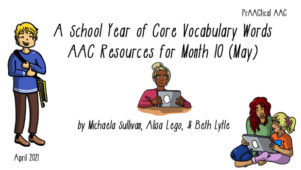
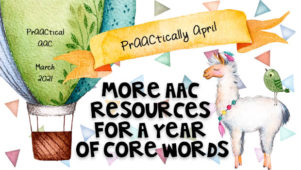
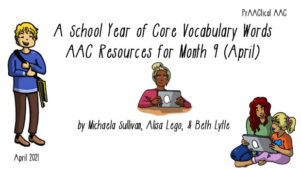
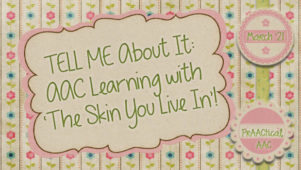
24 Comments
Really good article! It is simple and well written and I can use it to teach my teams for my students who are beginning and developing AAC users. I am an AAC SLP in a very large school district in Canada.
Thanks so much, Ann-Maree. We’d love to hear more about how the AAC services work in your district sometime.
Carole –
This might seem like a rookie question, but here I go! 🙂 If we are just starting a student on a no-tech, leveled core vocabulary board and their prior AAC experience was PECS, would you recommend a pick-up-and-give format to use part of a strategy they are familiar with? Or teach them the core board as a new system with a new format/access method (pointing)?
We are excited to move past PECS with this kiddo! Thanks for any input you can offer!
Rachael
Hey Rachael, not a rookie question at all! So, it’s hard to tell what is best for any particular learner but, in general, I move away from the systems with removable pieces as fast as I can. For one thing, it makes the kiddos dependent on us to ‘re-set’ the system after they use it to say an utterance. E.g., removes symbols to make the sentence ‘want more music’ then I have to put each symbol back so he can find/get it next time. I’ve had more success going with a core language board (or book, app, whatever was selected) which makes that unnecessary. Hope that makes sense.
That makes sense! Plus, fewer pieces to replace as they walk off. 🙂 Thanks to Pinterest and your blog, I’ve seen some great bulletin board sized core vocab displays for classrooms. Those pieces are removable to focus on new target words, draw additional attention during instruction, etc. Is that correct?
Thanks for all you do!
Rachael
Yes, exactly. That way you can remove the piece from the poster-sized display to bring it closer to the students, if needed. Great for when we use focused language stimulation as an instructional strategy. 🙂
Hi Carole,
That’s an interesting article thank you. What AAC software (for iPad) would you recommend for a learner who is quite verbal but has very limited speech for her age (8) and poor pragmatic language?
Many thanks,
Claire
Claire, it’s hard to say without an evaluation to look at what features she needs in the app. So many options and the kids are all so different from one another…
Hi Carole,
I am working with a 14 yo who is profoundly deaf and autistic. Currently he communicates through sign language and has a full time interpreter with him at school. He has only had exposure to sign for about 2 1/2 years and has grown by leaps and bounds. Informally, he has an expressive vocabulary at about a 6 1/2 yo level and a receptive at about an 8 1/2 yo level. He is in a self-contained classroom with students with moderate-severe cognitive deficits, most of which are non-readers and at least half are non-verbal. I just started working with this student this year and see that he is very limited in his ability to communicate outside of the interpreter. His peers do not sign so he has limited communication with them. He has some written abilities and I believe this could eventually become another effective communication modality for him but now I want to focus on improving his ability to communicate socially with his same age peers. How would you start?
Thanks so much!
Hi Carla! Thanks for stopping by. This situation is exactly why I generally avoid an approach that focuses primarily on manual signs. Doing so automatically limits who you can communicate with, so I think you are absolutely on the right track in wanting to expand his expressive repertoire to include aided AAC. In terms of where to start, it would depend a lot on whether his communication partners can read or not. If so, then using a no tech communication solution, such as a communication book, would be one option. If not, we would need to go right to something with voice output. Given who his peers are, that seems like the direction to take. Either way, if he is expressively at 6.5 years, he is going to need a LOT of vocabulary. I would probably start by looking at how he does with some highly portable SGDs/mobile devices that are linguistically based. By that, I mean ones with a) rich core vocabulary across different parts of speech; b) access to morphology; c) organized in a way that allows for further language development. With your help, he will most likely expand his language really nicely with that kind of system. In the beginning, I would mask a lot of the words and reveal more each week. I would consider teaching him the device starting with words he already knows/says through signing. It would be great to give this kiddo access to features like babble and search so that he has some more control of his own language learning. I wouldn’t be surprised if he picked up word prediction, too. He’s a lucky guy having you at the helm, Carla!!
Thanks so much for your quick response. I contacted our AT specialist and student has an IPad that we can put an application on. I’m not sure what the county already has available for trial but do you have a recommendation?
Carla, there are some really good options! As you assess specific needs, you might want to look at apps like Speak For Yourself, Touch Chat with WordPower or Gateway, and LAMP Words for Life.
Hi Carole,
This is again in reference to the student referred to in previous comment (14yo deaf and autistic). Unfortunately, our county did not have the spps you had suggested. We did, however, a springboard lite. I know this device is discontinued (replaced by the Accent, I think?) but is software same as Words for Life?
Thanks!
Great article thank you. A good tool for tutors working with core language is the Wordie Tool from ABCD English at http://abcdEnglish.xyz/wordie which enables you to put in a text (for example a news article) to identify the words which are not in core vocabulary, and so may need additional explanation or translation depending on the environment.
Thanks for stopping by and taking the time to tell us about Wordie. I can see using it in a few different ways with some of our AAC learners.
Thanks Carole, and any feedback/suggestions would be appreciated too. JL
Hi Carole!
I am currently working in a school where most kids use PECS at the phase I level. Since their PECS books contain little to no functional communication (especially for the summer school setting), I have introduced a basic core board for most of the kiddos and many of them are taking to it very quickly. I want to send the core board we’ve been using here home with the kids for the summer. Do you think I NEED to train the parents with the core board before sending it home? I’m not sure I will be able to meet with the parents, but I want SOMETHING in place at home for the kids. I was thinking about attaching the core board and a letter to parents (about the core board, opportunities to teach vocab, etc.) along with their progress reports. Sorry for the novel-ha! Do you think this is a good idea without parent training? Thank you!!!!
Lisa, thanks so much for your comment and the terrific question you posed. First of all, that clapping sound you hear is me applauding you for presuming competence and providing your kiddos with high frequency words that can complement their use of PECS. Way to go, Lisa!!! In a perfect world, it would be great to be able to provide the parents with information, training, practice, and support as you are sharing the core boards you are working with. However, in the real world, things don’t often work out that way. If you can provide the training, by all means, do so. If not, you might want to think about sending them anyway with a note about what you are doing and why. There is an increasingly powerful community of AAC parents out there who ‘get it’ and are working to support each other. I’d connect any families who show interest with some of their Facebook groups. (I blogged about those here: http://praacticalaac.org/praactical/five-facebook-groups-for-families-of-beginning-communicators/). You can probably come up with some really creative ways to support the parents from afar with short 5-minute screencasts (you can email them the link), handouts, etc. I’d say, go for it and supplement with as much training as you can, however you can, whenever you can. You are on the right track with this, in my humble opinion. Please keep in touch!
Hi Carol, an excellent and super practical introduction to Core Vocabulary, thanks! I chose to use your article as a reference for a blog post I recently did about vocabulary acquisition between age one and three years old (read it here if you are interested: https://www.adam-mila.com/milestones/language-development/vocabulary/ ). I am not so familiar with AAC, but I am curious to ask if you find that the principles behind teaching core vocabulary using AAC method are equally useful for boosting learning in children with typical development?
You have the most beautiful and helpful blog page! Love your graphics.
I am new to the AT field, but have taught in sped. for 15 years. A neighbor’s child is nonverbal/AU and has aged out of public school (is now 23). I am confident that this young man has never had any kind of exposure to anything AAC as he was “home schooled” in Mexico until he was 18. He understands English quite well. My question is it ever too late to give a no-tech device such as a core board a try?
Years ago, I printed the exact core board pictured above as well as a selection of fringe vocabulary to attach at the top with rings. It was a wonderful low tech resource. Alas, it walked off and I haven’t been able to find the original download anywhere. Is this still an available resource?!
CORE BOARDS ARE BAD THEY TRAP PEOPLE USE S2C, RPM OR FACILTED COMMUNICATION INSTEAD THESE ARE MUCH BETTER FOR THE PEOPLE USING THEM